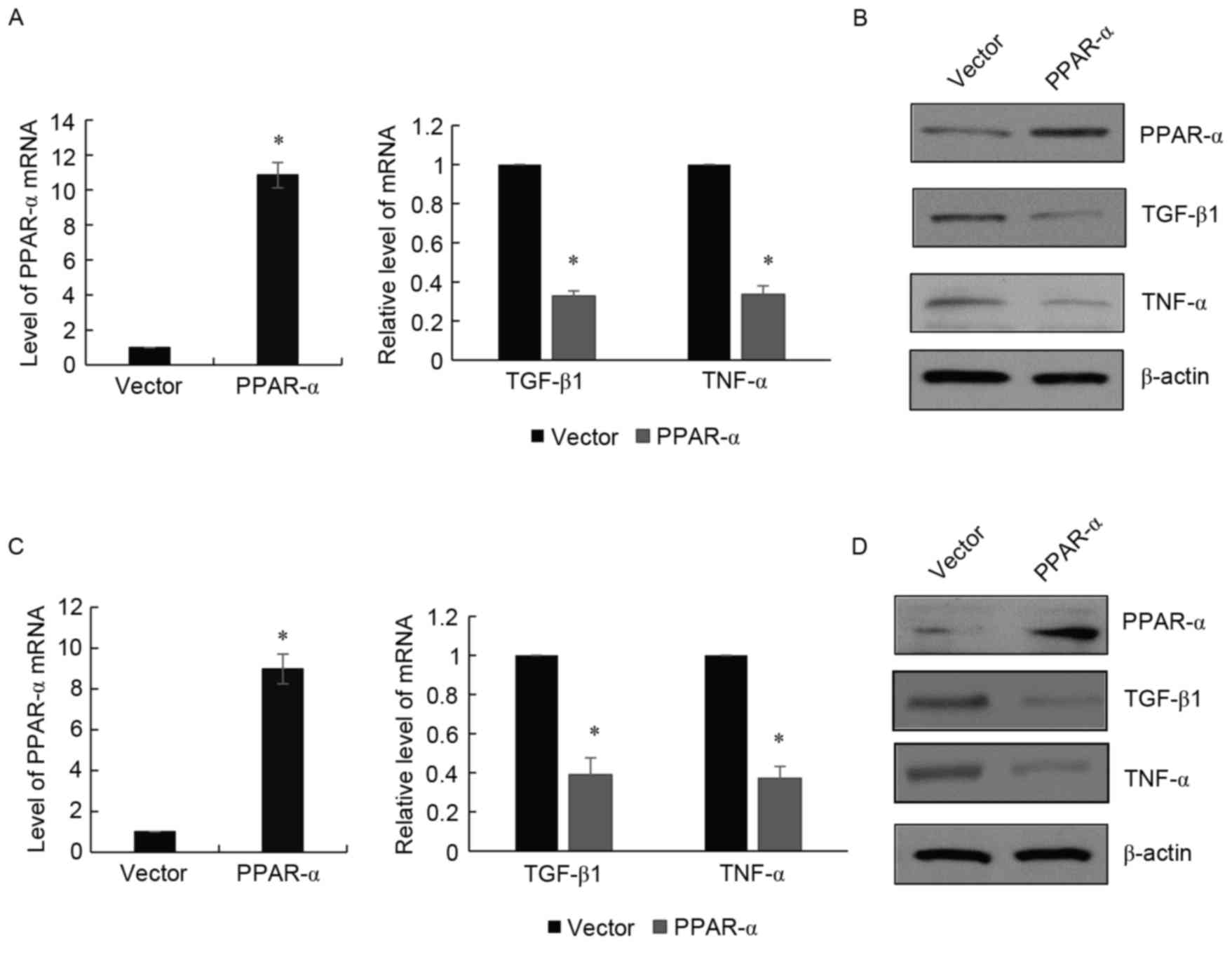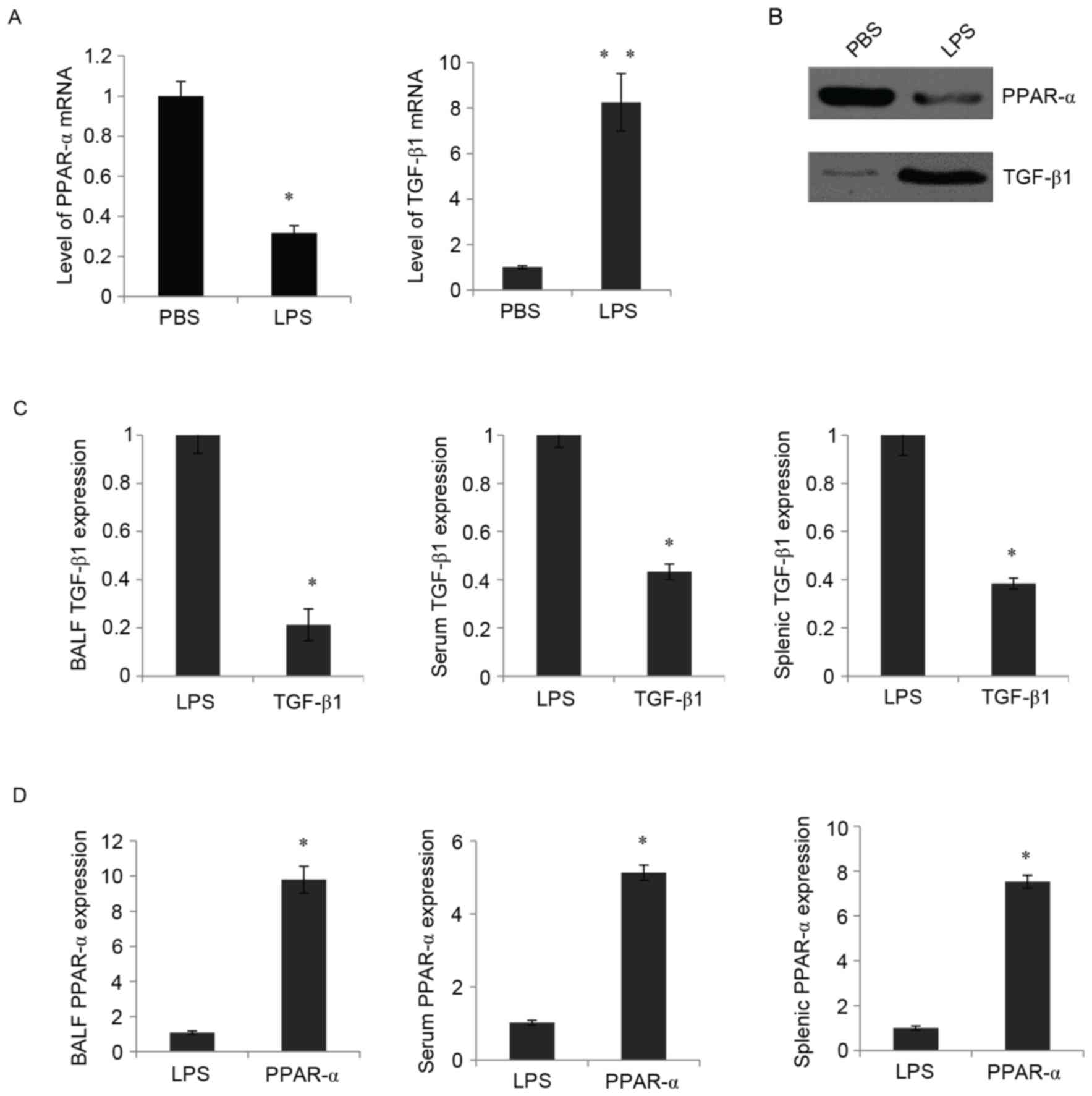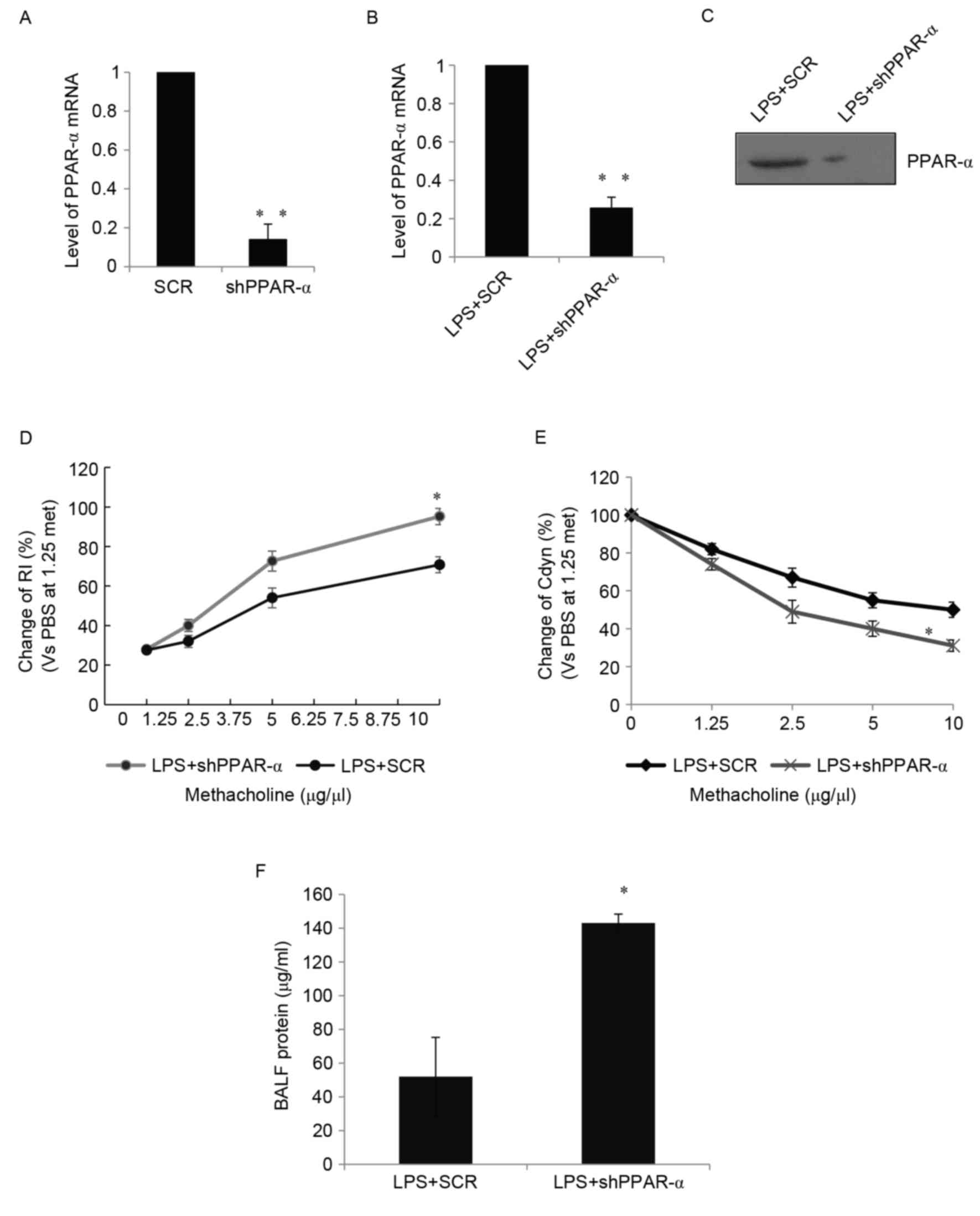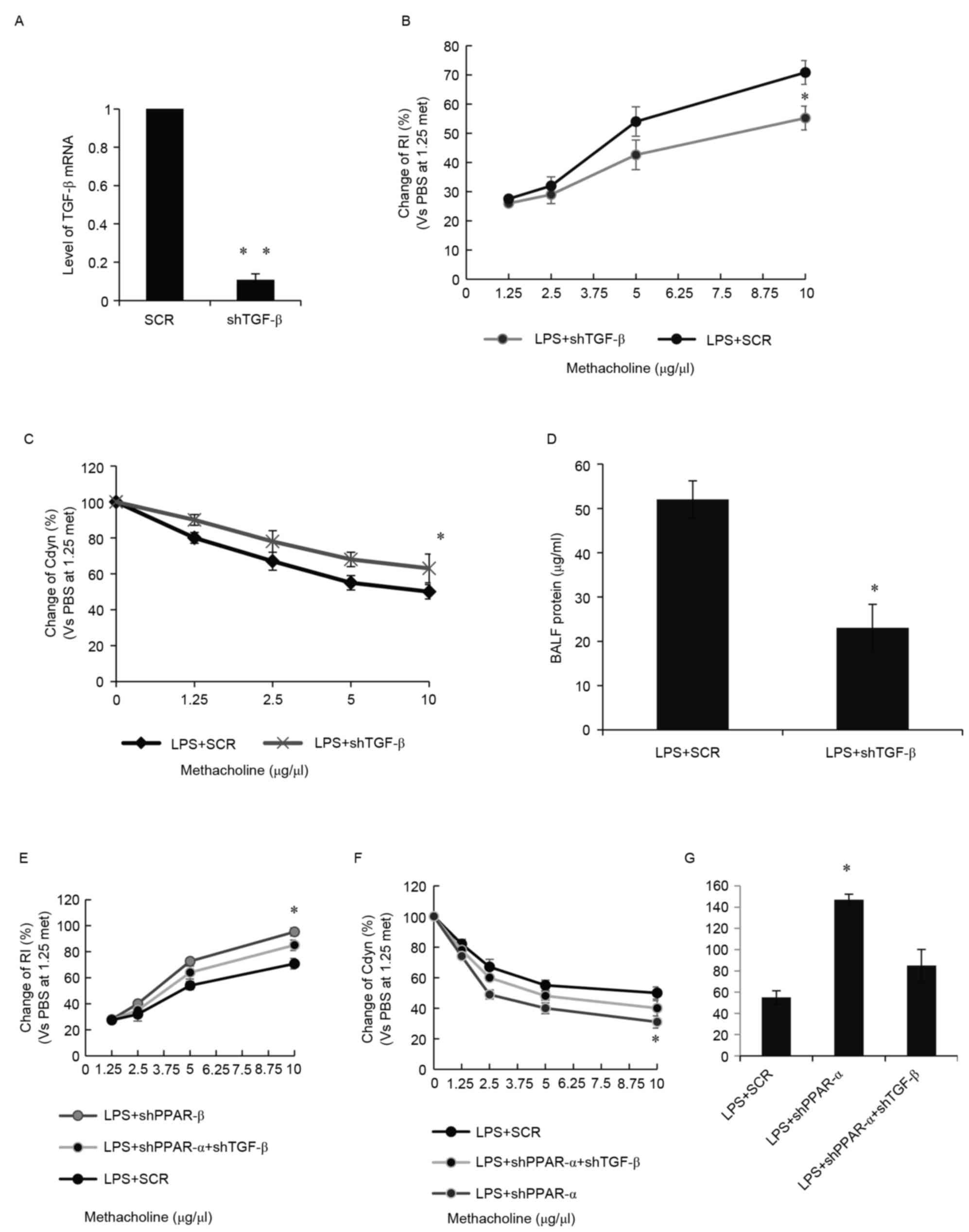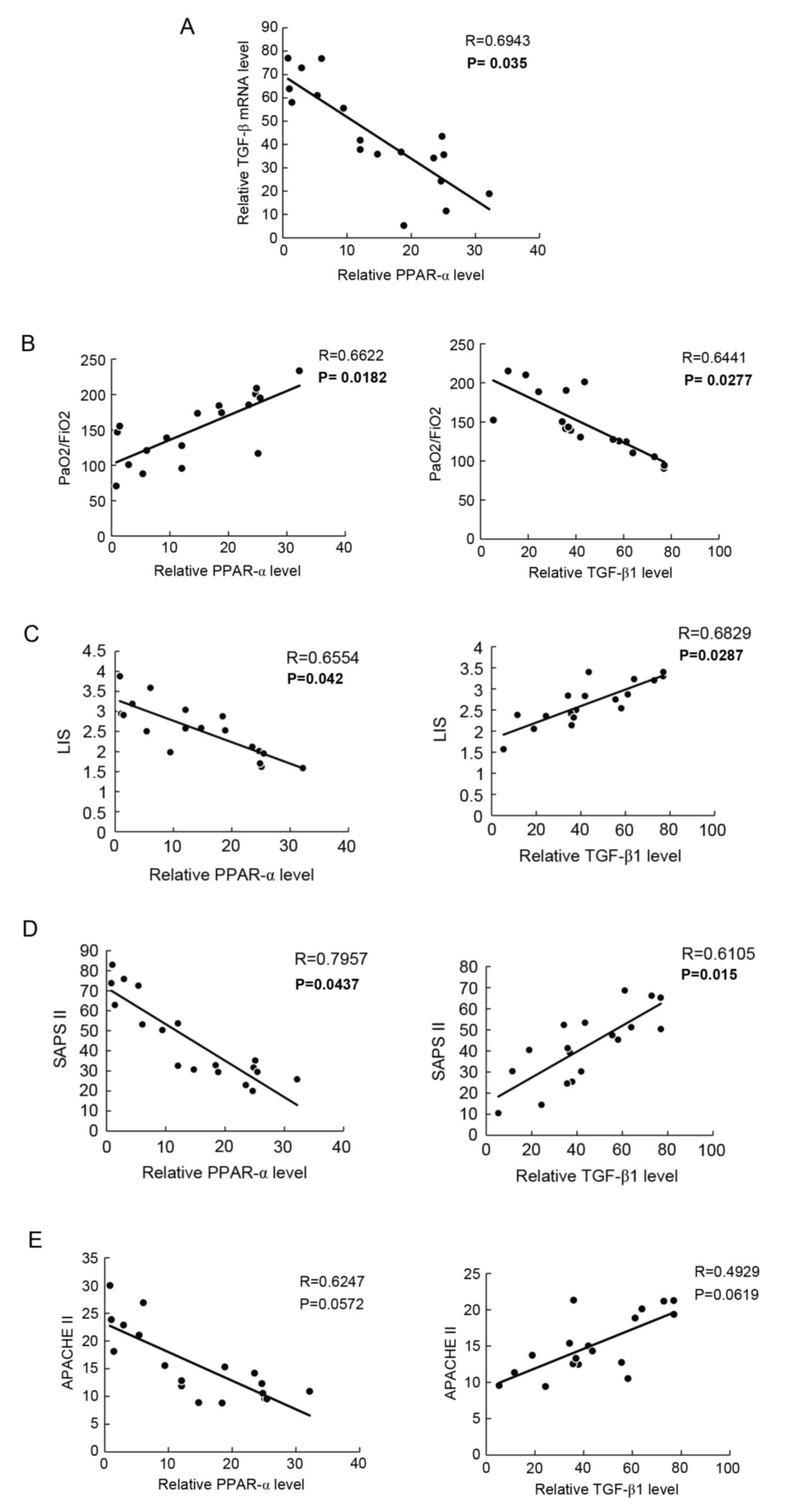PPAR-α improves the recovery of lung function following acute respiratory distress syndrome by suppressing the level of TGF-β1
- Authors:
- Published online on: May 10, 2017 https://doi.org/10.3892/mmr.2017.6562
- Pages: 49-56
-
Copyright: © Liu et al. This is an open access article distributed under the terms of Creative Commons Attribution License.
Abstract
Introduction
Acute respiratory distress syndrome (ARDS), the most severe form of acute lung injury (ALI), is the leading cause of acute respiratory failure, and has a mortality rate of ~40% worldwide (1), with a variety of detrimental clinical disorders, including hypoxemia, respiratory distress and pulmonary edema (2,3). Although the morbidity and mortality rates associated with ARDS in patients has decreased due to advances in protective ventilation (4) and fluid conservative supportive treatments (5), those surviving suffer from significant physical impairments (6). Therefore, improved comprehension of the molecular mechanism of ARDS is urgently required.
In the majority of cases, ARDS is induced by inflammatory pulmonary diseases or bacterial sepsis, and Gram-negative bacteria are common culprits (7). The endotoxin of Gram-negative bacteria, lipopolysaccharide (LPS), has been reported to be important in eliciting lung inflammation by inducing proinflammatory cytokines, including tumor necrosis factor (TNF)-α, interleukin (IL)-6, IL-1β and IL-8 (8), which increase the infiltration of inflammatory cells to the lungs in the development of ALI. Pro-inflammatory gene expression can be inhibited by the activation of peroxisome proliferator-activated receptor (PPAR)-α (9), which is a member of the ligand-activated transcription factors involved in the nuclear hormone receptor superfamily (10,11).
Transforming growth factor-β (TGF-β) signaling has been reported to be important in development and disease. TGF-β is known to be a major inducer of epithelial to mesenchymal transition via the small mothers against decapentaplegic (Smad)-dependent or Smad-independent pathways (12,13). Previous studies have reported that, through the stimulation of fibroblast proliferation, TGF-β1 is involved in ARDS, which leads to the development of pulmonary fibrosis. Pretreatment with rosiglitazone, a ligand of PPAR-γ, can protect against ALI by repressing the activation of nuclear factor-κB and inhibiting TGF-β signaling (14). However, whether PPAR-α is involved in TGF-β signaling, and whether PPAR-α is involved for the recovery of lung function following ALI, remain to be fully elucidated. The aim of the present study was to investigate the protective effects of PPAR-α in LPS-induced ALI in vivo and in vitro, and examine the underlying mechanisms involving the PPAR-α and TGF-β signaling pathway.
Materials and methods
Patient selection
The present study was approved by the Ethics Committee of Zigong First People's Hospital. A total of 18 patients (including 8 females and 10 males, ages 55–75) with ARDS caused by sepsis were enrolled between June 2010 and October 2013. All peripheral blood samples were collected with written informed consent. The clinical characteristics of ARDS were summarized and disease severity was determined using the Acute Physiology and Chronic Health Evaluation (APACHE) II, the Murray Lung Injury Score (LIS) and the Simplified Acute Physiology Score (SAPS) II (15). The characteristics of patients with ARDS were as follows: i) PaO2/FiO2 ≤300; ii) presence of bilateral pulmonary infiltrates on frontal chest radiograph; iii) no clinical evidence of left atrial hypertension; iv) requirement for positive pressure ventilation via an endotracheal tube; v) composite of oxygenation, compliance, positive end expiratory pressure and the appearance of chest radiograph (16). Blood was collected using an indwelling arterial catheter at the time of ICU admission (baseline) into sterilized, silicone-coated glass tubes, and at 3 and 7 days subsequently. Healthy blood donors were used as controls (also including 8 females and 10 males, ages from 55–75). Serum samples (4 ml) were obtained by centrifugation at 2,500 × g for 10 min at room temperature and frozen at −70°C until use. The buffy coat cell layer was carefully aspirated and buffy coat cells were suspended. Concentrations of TGF-β1 and PPAR-α were determined using commercial, standardized enzyme-linked immunosorbent assay (ELISA) kits. The TGF-β1 ELISA kit (cat. no. ADI-900-155) was from Enzo Life Sciences, Inc. (Farmingdale, NY, USA) and the PPAR-α ELISA kit (cat. no. 40,196) was from Active Motif, Inc. (Carlsbad, CA, USA). The lower detection limit for TGF-β1 was 0.10 pg/ml and for PPAR-α was 0.30 pg/ml.
Cell lines and cell culture
Human lung fibroblast (HLFs; IMR-90 cells) and Mus musculus monocyte/macrophage RAW 264.7 cells were purchased from American Type Culture Collection (Manassas, VA, USA) and cultured in Eagle's Minimum Essential Medium with 10% fetal bovine serum (FBS; Invitrogen; Thermo Fisher Scientific, Inc., Waltham, MA, USA). The RAW 264.7 macrophages were cultured in Dulbecco's modified Eagle's medium containing 10% FBS. The cells were cultured in a humidified incubator at 37°C in 5% CO2.
Reagents
LPS (isolated from Escherichia coli) and TGF-β1 (used at a dose of 10 µg/ml) were purchased from Sigma-Aldrich; Merck Millipore (Darmstadt, Germany). Mouse monoclonal antibodies against TGF-β1 were from Abcam (cat. no. PB190503; Cambridge, MA, USA) and rabbit monoclonal antibody against PPARα was from Cell Signaling Technology, Inc. (cat. no. 2443S; Beverly, MA, USA). HRP-conjugated anti-mouse and anti-rabbit secondary antibodies were from Santa Cruz Biotechnology, Inc. (Dallas, TX, USA). Specific small interfering short hairpin (sh)RNA targeting TGF-β1 and PPAR-α and the negative control shRNA were all from Sigma-Aldrich; Merck Millipore. Following allowing cellular attachment to the plates, 2×105 cells were treated with relative shRNAs using Lipofectamine 2000 (Invitrogen; Thermo Fisher Scientific, Inc.) RNA and protein were collected 72 h following treatment.
Induction of ARDS in mice
All experiments involving mice were performed in strict accordance with Animal Care and Use guidelines from Beijing Charles River Laboratory Animal Centre institutional committee (Beijing, China). A total of 30 (15 male and 15 female) mice (8–10 weeks old; 19–22 g) were purchased from Beijing Charles River Laboratory Animal Centre, and kept under standard conditions at room temperature (24°C) with a 12 h day/night cycle under specific pathogen-free conditions. At 3 h following intratracheal instillation of LPS (4 mg/kg) (17), the mice were administered with an intravenous injection in the tail vein of 10% chloral hydrate (3.5 ml/kg) for anesthetization at 4, 12 and 24 h. The mice were divided into the following groups: Vector group, injected with the same volume of pyrogen-free PBS; LPS group, stimulated with LPS; PPARα group, pre-treated with PPAPα prior to stimulation with LPS. Following the successful induction of ALI, the mice were administered with a tail vein injection of adeno-associated viruses (AAV) carrying PPAR-α short hairpin RNA (shPPAR-α group) or with a scrambled (SCR) sequence as a control. Primary murine alveolar epithelial cells were isolated, as described previously (18).
RNA isolation and reverse transcription-quantitative polymerase chain reaction (RT-qPCR) analysis
Total RNA was extracted from the cultured cells using TRIzol reagent (Invitrogen; Thermo Fisher Scientific, Inc.). For analysis of the expression of messenger RNA (mRNA), cDNA synthesis was performed by reserve transcription using the Transcriptor First Stand cDNA synthesis kit (Roche Diagnostics, Basel, Switzerland). The qPCR was performed in duplicate with a QuantiTect SYBR Green PCR kit (Qiagen, Inc., Valencia, CA, USA) on an Applied Biosystems 7500 Real-Time PCR system (Applied Biosystems; Thermo Fisher Scientific, Inc.), according to manufacturer's protocol. The primers were as follows: TGF-β1, forward 5′-CCACCTGCAAGACCATCGAC-3′ and reverse: 5′-CTGGCGAGCCTTAGTTTGGAC-3; PPARγ, forward 5′-GAGATCATCTACACGATGCTGGC-3′ and reverse 5′-CGCAGGCTTTTGAGGAACTC-3′; and GAPDH, forward 5′-GAGAAGTATGACAACAGCCTC-3′ and reverse 5′-ATGGACTGTGGTCATGAGTC-3′. All primers were purchased from Thermo Fisher Scientific, Inc. The PCR amplification was performed at 95°C for 1 min, followed by 35 cycles of 95°C for 15 sec, 60°C for 15 sec, and 72°C for 30 sec. The expression levels of genes were normalized against that of GAPDH and relative fold changes in mRNA expression were calculated using the formula 2−ΔΔCq (19).
Western blot analysis
Whole cell lysates were collected and protein from the cultured cells was extracted using RIPA lysis buffer on ice, following centrifugation at 4°C, 10,000 × g for 15 min, the supernatants were collected. The BCA protein assay kit (Thermo, USA) was used to determine the protein concentration, and 30 µg from each sample was mixed with 4X SDS loading buffer and heated at 100°C for 10 min. Protein samples were then separated by 10% SDS-polyacrylamide gel electrophoresis and transferred onto a PVDF membrane (EMD Millipore, Billerica, MA, USA). A mixture of 5% non-fat milk in Tris-buffered saline Tween-20 (TBST) was used to block the nonspecific proteins for 1 h at room temperature. The membrane blots were then probed with primary antibodies at 4°C overnight, as follows: PPAR-α (1:500), TGF-β1 (1:1,000), TNF-α (1:1,000), and β-actin (1:2,000). The membranes were washed five times with TBST for 5 min, followed by incubation with horseradish peroxidase-conjugated secondary antibody (Santa Cruz Biotechnology, Inc.) for 1 h at room temperature. An enhanced chemiluminescent system (GE Healthcare Life Sciences, NJ, USA) was used to visualize the protein antigen. The signals were recorded using X-ray film (Kodak, Rochester, NY, USA). Images were captured, representative of three repeats.
ELISA
The levels of PPAR-α and TGF-β1 in the bronchoalveolar lavage fluid (BALF), serum and cell culture supernatants were determined using sandwich ELISA, according to the manufacturer's protocol.
Statistical analysis
All statistical analyses were performed using SPSS 18.0 statistical software (SPSS, Inc., Chicago, IL, USA). Data were analyzed by comparing the mean ± standard deviation from three experiments using Student's t-test P<0.05 was considered to indicate a statistically significant difference. One-way analysis of variance with a Bonferoni correction was used for statistical analysis, followed by a Fisher's exact test, as necessary.
Results
PPAR-α is effective at suppressing TGF-β in HLF cells and RAW 264.7 cells
In order to investigate whether PPAR-α was involved in TGF-β signaling, the present study treated HLFs with PPAR-α and, 48 h following treatment, the cells were harvested. The mRNA and nuclear proteins were isolated, followed by the examination of TGF-β1 using RT-qPCR and western blot analyses. It was found that PPAR-α inhibited the expression of TGF-β1 in HLF cells at the mRNA level (Fig. 1A) and protein level (Fig. 1B); the suppression of TNF-α by PPAR-α was used as a positive control. To further confirm these findings, RAW 264.7 cells were used and a similar experiment was performed. As shown in Fig. 1C and D, the expression of TGF-β1 was suppressed by the enforced expression of PPAR-α.
PPAR-α treatment downregulates the expression of TGF-β1 in the mouse model of LPS-induced ALI
To further investigate the roles of PPAR-α and TGF-β1 in ALI, LPS-induced ALI mice were used, and the expression levels of PPAR-α and TGF-β1 were examined using RT-qPCR and western blot analyses. Following LPS treatment, in the murine lung, a decrease in the mRNA expression of PPAR-α and an increase in the mRNA expression of TGF-β1 were observed using RT-qPCR analysis (Fig. 2A). Similarly, the western blot analysis showed that the protein expression PPAR-α was decreased and that of TGF-β1 was significantly increased by treatment with LPS (Fig. 2B). PPAR-α treatment prior to stimulation with LPS resulted in a decrease in the mRNA expression levels of TGF-β1 in the BALF, peripheral blood and splenocytes (Fig. 2C). Consistently, the present study found that the expression level of PPAR-α in the BALF was significantly elevated by treatment with the PPAR-α expression vector (Fig. 2D, left panel). The expression levels of PPAR-α in the peripheral blood and splenocytes were also upregulated (Fig. 2D, middle and right panels). These findings demonstrated that the enforced expression of PPAR-α downregulated the expression of TGF-β1 in LPS-induced ALI mice.
Activation of PPAR-α is essential for recovery of lung function following ALI
The question of whether PPAR-α was involved in the recovery of lung function following ALI remained; therefore, to evaluate the role of PPAR-α in the recovery of lung function, the present study developed a virus carrying the shPPAR-α or SCR sequence as a control. It was found that the RAW 264.7 cells, which were transduced with shPPAR-α, exhibited significantly decreased levels of PPAR-α (Fig. 3A). Following injecting of the virus expressing either shPPAR-α or SCR into the mouse following LPS treatment, the effects of PPAR-α on lung recovery were examined. Significantly decreased levels of PPAR-α in the mouse lung were detected using RT-qPCR analysis (Fig. 3B) and western blot analysis (Fig. 3C). Impaired lung function has been considered to cause a dose-dependent increase in lung resistance index (RI) and decrease in dynamic compliance (Cdyn) in response to a cholinergic stimulus (methacholine) and a significant increase in BALF protein (11). The analysis of pressure and flow waveforms indicated that the knockdown of PPAR-α resulted in a marked increase in RI (Fig. 3D), a notable decrease in Cdyn (Fig. 3E) and a significant increase in BALF protein (Fig. 3F). These data suggested that PPAR-α was essential for the recovery of lung function following ALI.
Suppression of TGF-β by PPAR-α improves recovery of lung function following ALI
In order to further evaluate the association between TGF-β with PPAR-α in the recovery of lung function following ALI, TGF-β1 was inhibited in the mouse lung following LPS treatment by injecting AAV expressing shTGF-β1 (or SCR as a control). TGF-β1-knockdown efficiency was first confirmed in the mouse lung. It was found that the application of these viruses significantly decreased the levels of TGF-β1 (Fig. 4A), resulting in a significant decrease in RI (Fig. 4B), a significant increase in Cdyn (Fig. 4C) and a significant decrease in BALF protein (Fig. 4D). These data suggested that shTGF-β1 was essential for the recovery of lung function following ALI. The results showed that the knockdown of PPAR-α and knockdown of TGF-β1 in the mouse lung partially reduced the shPPAR-α-impaired recovery of lung function, as detected by RI (Fig. 4E), Cdyn (Fig. 4F) and BALF protein (Fig. 4G). Together, these experiments suggested that PPAR-α was essential for the recovery of lung function following ALI, possibly through the suppression of TGF-β.
Serum levels of PPAR-α are negatively correlated with TGF-β1 in patients with ARDS
To further investigate the clinical significance of the above-mentioned findings, the present study detected the serological expression levels of PPAR-α and TGF-β1, which revealed that PPAR-α was inversely correlated with TGF-β1 in patients with ARDS (Fig. 5A; P<0.05). In addition, the correlation with disease activity in patients with ARDS was analyzed. It was found that serum PPAR-α was positively associated with the ratio of PaO2/FiO2, whereas the serum level TGF-β1 was negatively associated with PaO2/FiO2 (Fig. 5B; P<0.05).
Using the LIS (Fig. 5C; P<0.05) and SAPS II (Fig. 5D; P<0.05) scoring methods to determine disease activity, it was revealed that the serum expression level of PPAR-α was inversely correlated with these indices, whereas the serum expression level of TGF-β1 was consistent with these indices. No significant correlation was observed between the APACHE II scoring method and PPAR-α or TGF-β1 serum levels (Fig. 5E; P>0.05). On the whole, these results suggested that PPAR-α was negatively correlated with TGF-β1 and involved in the pathogenesis of ARDS.
Discussion
One of the primary findings of the present study was that PPAR-α was effective in suppressing TGF-β1 in HLF cells and RAW 264.7 cells. The present study further analyzed the levels of TGF-β1 and PPAR-α in the mouse lung following LPS treatment. In the murine lung, there was a decrease in the mRNA expression of PPAR-α and an increase in the mRNA expression of TGF-β1. Treatment with PPAR-α prior to stimulation with LPS resulted in a dose-dependent decrease in the expression levels of TGF-β1 in BALF, peripheral blood and splenocytes. The above data indicated that PPAR-α treatment downregulated the expression of TGF-β1 in the LPS-induced ALI model in vitro and in vivo. Taken together, the present study demonstrated that the enforced expression of PPAR-α ameliorated the development of ALI using the LPS-induced model. Following the report that TNF-α is one of the primary cytokines involved in the response to LPS, the present study revealed that, in addition to TNF-α, TGF-β1 was another key regulator in LPS-induced ALI.
In order to further elucidate the molecular mechanism underlying post-ALI lung recovery, the present study further focused on whether the suppression of TGF-β1 by PPAR-α was involved in the recovery of lung function following ALI. The knockdown of PPAR-α and knockdown of TGF-β1 in the mouse lung partially reduced the shPPAR-α impaired recovery of lung function, and it was concluded that the activation of PPAR-α and suppression of TGF-β1 were essential for the recovery of lung function. The clinical significance of PPAR-α being inversely correlated with TGF-β1 in patients with ARDS was consistent with this mechanism. Taken together, the results of the present study provided evidence supporting critical role of PPAR-α in the suppression of TGF-β1 in lung recovery, and revealed a novel mechanism controlling post-ALI lung recovery.
References
|
Rubenfeld GD, Caldwell E, Peabody E, Weaver J, Martin DP, Neff M, Stern EJ and Hudson LD: Incidence and outcomes of acute lung injury. N Engl J Med. 353:1685–1693. 2005. View Article : Google Scholar : PubMed/NCBI | |
|
Ware LB and Matthay MA: The acute respiratory distress syndrome. N Engl J Med. 342:1334–1349. 2000. View Article : Google Scholar : PubMed/NCBI | |
|
Taeusch HW: Treatment of acute (Adult) respiratory distress syndrome. The holy grail of surfactant therapy. Biol Neonate. 77:(Suppl 1). S2–S8. 2000. View Article : Google Scholar | |
|
Acute Respiratory Distress Syndrome Network. Brower RG, Matthay MA, Morris A, Schoenfeld D, Thompson BT and Wheeler A: Ventilation with lower tidal volumes as compared with traditional tidal volumes for acute lung injury and the acute respiratory distress syndrome. N Engl J Med. 342:1301–1308. 2000. View Article : Google Scholar : PubMed/NCBI | |
|
Reisinger MW, Moss M and Clark BJ: National Heart, Lung, and Blood Institute Acute Respiratory Distress Syndrome Network Investigators: Brief versus full alcohol use disorders identification test in national heart, lung, and blood institute acute respiratory distress syndrome network clinical trials. Crit Care Med. 43:e382–e385. 2015. View Article : Google Scholar : PubMed/NCBI | |
|
Thompson BT and Matthay MA: The Berlin definition of ARDS versus pathological evidence of diffuse alveolar damage. Am J Respir Crit Care Med. 187:675–677. 2013. View Article : Google Scholar : PubMed/NCBI | |
|
Martin MA and Silverman HJ: Gram-negative sepsis and the adult respiratory distress syndrome. Clin Infect Dis. 14:1213–1228. 1992. View Article : Google Scholar : PubMed/NCBI | |
|
Bhatia M and Moochhala S: Role of inflammatory mediators in the pathophysiology of acute respiratory distress syndrome. J Pathol. 202:145–156. 2004. View Article : Google Scholar : PubMed/NCBI | |
|
Chen C, Xu S, Wang WX, Ding YM, Yu KH, Wang B and Chen XY: Rosiglitazone attenuates the severity of sodium taurocholate-induced acute pancreatitis and pancreatitis-associated lung injury. Arch Med Res. 40:79–88. 2009. View Article : Google Scholar : PubMed/NCBI | |
|
Schaefer MB, Pose A, Ott J, Hecker M, Behnk A, Schulz R, Weissmann N, Günther A, Seeger W and Mayer K: Peroxisome proliferator-activated receptor-alpha reduces inflammation and vascular leakage in a murine model of acute lung injury. Eur Respir J. 32:1344–1353. 2008. View Article : Google Scholar : PubMed/NCBI | |
|
Delerive P, De Bosscher K, Besnard S, Vanden Berghe W, Peters JM, Gonzalez FJ, Fruchart JC, Tedgui A, Haegeman G and Staels B: Peroxisome proliferator-activated receptor alpha negatively regulates the vascular inflammatory gene response by negative cross-talk with transcription factors NF-kappaB and AP-1. J Biol Chem. 274:32048–32054. 1999. View Article : Google Scholar : PubMed/NCBI | |
|
Derynck R and Zhang YE: Smad-dependent and Smad-independent pathways in TGF-beta family signalling. Nature. 425:577–584. 2003. View Article : Google Scholar : PubMed/NCBI | |
|
Rastaldi MP: Epithelial-mesenchymal transition and its implications for the development of renal tubulointerstitial fibrosis. J Nephrol. 19:407–412. 2006.PubMed/NCBI | |
|
Wu M, Melichian DS, Chang E, Warner-Blankenship M, Ghosh AK and Varga J: Rosiglitazone abrogates bleomycin-induced scleroderma and blocks profibrotic responses through peroxisome proliferator-activated receptor-gamma. Am J Pathol. 174:519–533. 2009. View Article : Google Scholar : PubMed/NCBI | |
|
Bernard GR, Artigas A, Brigham KL, Carlet J, Falke K, Hudson L, Lamy M, Legall JR, Morris A and Spragg R: The American-European Consensus Conference on ARDS. Definitions, mechanisms, relevant outcomes, and clinical trial coordination. Am J Respir Crit Care Med. 149:818–824. 1994. View Article : Google Scholar : PubMed/NCBI | |
|
Murray JF, Matthay MA, Luce JM and Flick MR: An expanded definition of the adult respiratory distress syndrome. Am Rev Respir Dis. 138:720–723. 1988. View Article : Google Scholar : PubMed/NCBI | |
|
Wang H, Xu L, Zhao J, Wang D, Guo R, Wang J, Gong W, Liu T, Zhang Y and Dong L: Regulatory mechanism of pyrrolidine dithiocarbamate is mediated by nuclear factor-κB and inhibits neutrophil accumulation in ARDS mice. Exp Ther Med. 8:614–622. 2014.PubMed/NCBI | |
|
Rastaldi MP: Epithelial-mesenchymal transition and its implications for the development of renal tubulointerstitial fibrosis. J Nephrol. 19:407–412. 2006.PubMed/NCBI | |
|
Livak KJ and Schmittgen TD: Analysis of relative gene expression data using real-time quantitative PCR and the 2(−Delta Delta C(T)) method. Methods. 25:402–408. 2001. View Article : Google Scholar : PubMed/NCBI |



